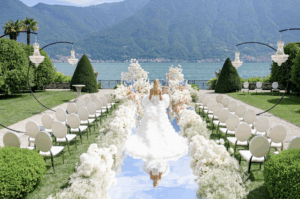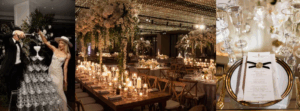
For most, the day of their wedding is among one of the happiest days of their lives. In a sea of roses, tulle, and champagne, surrounded by their closest friends and family, they profess their love for another individual, until death do they part. This day (hopefully) marks the beginning of the greatest chapter in their lives, with all the glitz and glamour to inspire the longevity of their relationship.
Among the worst days however, is when that bill hits their, or their parents’, desk. Today, the steps and costs to acquire each aspect of one’s special day is often more than putting a down payment on a house or paying for a car. In recent years, the wedding industry has blown out of proportion, with almost 26% of couples spending $30,000 to $44,999 on their festivities. This represents a 30% jump from 2019, an outrageous statistic that showcases the influence of media and societal expectations on decisions being made. The cost of weddings traditionally entails a venue rental, catering, bridal gown and attire, entertainment, and a planner to make sure all of these elements remain coherent on the day of the event. Unfortunately, the standards of contemporary weddings have elevated, tacking on many more “necessary” costs to the bill.
What once were wedding luxuries have now become the norm. Destination weddings are more popular now than ever. Films such as Anyone But You showcase the regality of an international ceremony. Similarly, former reality tv-show star Kalani Hiliker of Dance Moms hosted a public Lake Como wedding this past week which appeared almost as a performance to the media. These seemingly “normal” people have begun influencing viewers to book plane tickets and an Airbnb for their closest loved ones. While you could argue that a little extravagance never hurts, it is unrealistic to ask friends for over a week of their time, oftentimes requiring the use of PTO at work and separation from their family, to attend a one-day event. Similarly, to make room in the budget for more elaborate things of the wedding, planners have begun suggesting offsetting these costs onto the participants. For example, brides have started asking bridesmaids to pay for their own dresses, creating the narrative that this way they get to choose which dress they wear. Additionally, instead of paying for an open bar and risking a drunken event, couples have opted for a cash bar, requesting that guests pay for their drinks if they want to partake.

The inflation of the wedding standard doesn’t stop there. Whether domestic or international, these weddings have gotten out of hand in terms of decorations, food, and even the tiniest of details. For some, it means designer wedding gowns, monogrammed plates and napkins, and drone light shows. For others, a champagne tower, luxury swag bags, and wedding weekends are the norm. Let’s not forget that the wedding is only the final stop on this adventure. There are bridal showers, bachelor/bachelorette weekends, and rehearsal dinners to attend as well, all with their own curated costs, elegant wardrobes, and time off requests for work. And to top it all off, you need a top-of-the-line photographer and videographer, which must be separate people, to capture your beautiful day in one swift motion. If their portfolio isn’t absolutely jaw-dropping (with equally astounding pricetags), then you should not even bother giving them a call.
So why can’t the married couple just be happy? What does the surge of detailed wedding standards have to do with the success of a marriage? Nothing. In fact, another issue arises in that these extraordinary ceremonies and events create a facade that marriage is picture-perfect and filled with luxury. In an article by The Independent, the author recalls, “All of these events I am emotionally blackmailed into attending, based on the premise that it’s a ‘once in a lifetime’ thing, when all the statistics suggest that a hefty proportion of them will end in divorce within a decade” (Devon, 2013). These extravagant weddings, especially when they gain attention in the media, mislead brides and grooms-to-be that they need to spend half of their yearly income in order to prove their undying love and commitment to one another.
There is no doubt that the wedding industry has become an art in and of itself. The photography and videography, mixed with the color coordination and different textures, and the music and ambience to tie it all together for a beautiful masterpiece. However, at what costs, both ethically and economically, does this booming industry cross the line into extremity?






